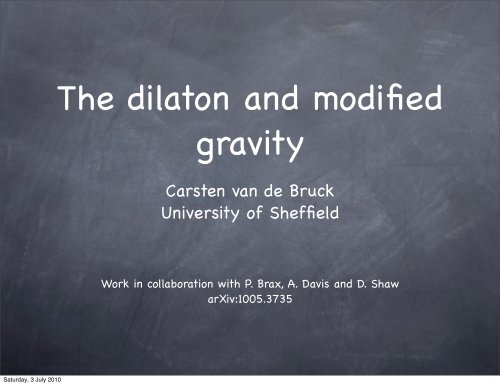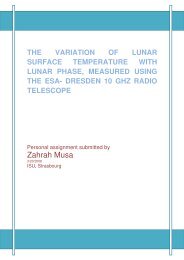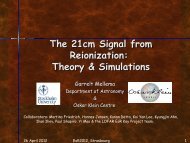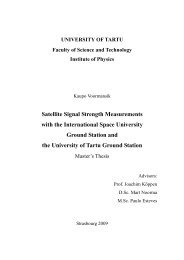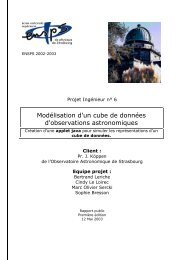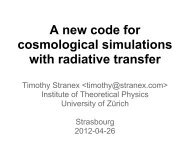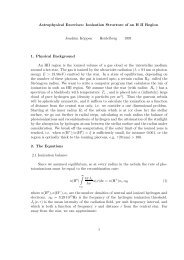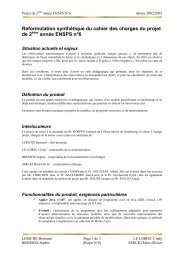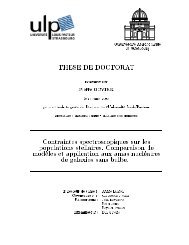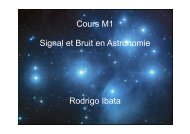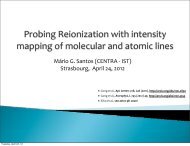Carsten van de Bruck University of Sheffield
Carsten van de Bruck University of Sheffield
Carsten van de Bruck University of Sheffield
You also want an ePaper? Increase the reach of your titles
YUMPU automatically turns print PDFs into web optimized ePapers that Google loves.
Saturday, 3 July 2010<br />
The dilaton and modified<br />
gravity<br />
<strong>Carsten</strong> <strong>van</strong> <strong>de</strong> <strong>Bruck</strong><br />
<strong>University</strong> <strong>of</strong> <strong>Sheffield</strong><br />
Work in collaboration with P. Brax, A. Davis and D. Shaw<br />
arXiv:1005.3735
Saturday, 3 July 2010<br />
Scalar Fields and Modified Gravity<br />
Scalar fields are common in particle physics (although not a single<br />
one has been observed).<br />
Usually those fields couple to matter.<br />
Properties are <strong>of</strong>ten difficult to reconcile with cosmology/gravity<br />
experiments.<br />
Examples: a) Dilaton in string theory, which couples to all matter<br />
forms and is rather light. b) Moduli fields in supersymmetry/gravity<br />
and/or string theory.<br />
Need mechanism to hi<strong>de</strong> those type <strong>of</strong> fields from current<br />
experiments, otherwise ruled out!
Saturday, 3 July 2010<br />
Here we consi<strong>de</strong>r two mechanisms<br />
to “hi<strong>de</strong>” the scalar field(s):<br />
Damour-Polyakov (DP) mechanism<br />
(Damour&Polyakov, Nucl.Phys.B 423, 532 (1994))<br />
The Chameleon Mechanism<br />
(Khoury&Weltman, Phys.Rev.D 69, 044026 (2004))
Saturday, 3 July 2010<br />
Chameleon mechanism<br />
(for h(Φ)=1):<br />
Chameleon effect is based on interactions <strong>of</strong> field with ambient matter<br />
and nonlinear self-interactions.<br />
Essential for chameleon mechanism is the thin-shell solutions to the<br />
field equation! 80<br />
!!! [M]<br />
60<br />
40<br />
20<br />
0 40 80 120 160<br />
r [M -1 0<br />
]
Saturday, 3 July 2010<br />
Chameleon mechanism:<br />
The force (given by the gradient <strong>of</strong> the scalar field) is suppressed<br />
outsi<strong>de</strong> the body.<br />
Not all bodies have this thin shell! Field can behave as a standard<br />
massive scalar field and force can be long-ranged.<br />
Field follows an effective potential, which consists <strong>of</strong> the bare<br />
potential and a part which <strong>de</strong>pends on the ambient matter<br />
<strong>de</strong>nsity:<br />
Veff(φ) =V (φ)+ρmatterA(φ)
The coupling, usually given by<br />
β =<br />
∂ ln A(φ)<br />
∂φ<br />
is in the case <strong>of</strong> a thin shell given by<br />
β 2 eff = β 2 |φ∞ − φc|<br />
βΦN (R)<br />
This results in constraints on the theory!<br />
Saturday, 3 July 2010
Not all scalar-tensor theories are chameleon<br />
theories!! Thin-shell solution essential!! Whether<br />
or not a thin-shell solution exists, <strong>de</strong>pends on<br />
the potential V and the coupling function A!<br />
What about the string-theory dilaton? We<br />
require ßeff to be small. Consi<strong>de</strong>r a theory for<br />
which<br />
Saturday, 3 July 2010<br />
A(φ) =e βφ<br />
V (φ) =V0e −φ
The Damour-Polyakov mechanism<br />
This mechanism is operating in theories in which<br />
the coupling function A(ϕ) has a minimum. The<br />
coupling<br />
β =<br />
∂ ln A(φ)<br />
∂φ<br />
is zero at this point. Cosmologically, the scalar<br />
field is driven to the minimum <strong>of</strong> A(Φ) if the bare<br />
potential <strong>van</strong>ishes! Damour and Polyakov (1994)<br />
applied this mechanism to the dilaton, ignoring the<br />
influence <strong>of</strong> V(Φ).<br />
Saturday, 3 July 2010
Saturday, 3 July 2010<br />
In our work we took the influence <strong>of</strong> the<br />
potential into account and promoted the dilaton to be<br />
a dark energy scalar field.<br />
Damour, Piazza & Veneziano (Phys.Rev.D 66,<br />
046007 (2002)) consi<strong>de</strong>red the dilaton as a dark<br />
energy field too, but in their case the minimum <strong>of</strong><br />
A(Φ) was at Φ=∞! Here, we consi<strong>de</strong>r the minimum <strong>of</strong><br />
A(Φ) at finite value: very different constraints on the<br />
theory and also cosmological behaviour is very<br />
different!
Due to the non-canonical nature <strong>of</strong> the scalar<br />
field (k(Φ) is not 1!), the coupling to matter is<br />
not β, but<br />
α = β(φ)2<br />
=<br />
k(φ) 2<br />
Cosmologically, if field is near the minimum:<br />
α =0.04...0.33<br />
<strong>de</strong>pending on λ. The field is long-ranged<br />
(cosmological scales)!<br />
Saturday, 3 July 2010<br />
β(φ) 2<br />
λ −2 +3β(φ) 2
Saturday, 3 July 2010<br />
Note that<br />
β(φmin) =<br />
V (φmin)<br />
4V (φmin)+A(φmin)ρm<br />
therefore β → 0 for ρ →∞<br />
The coupling α therefore tends to zero in<br />
large <strong>de</strong>nsity regions. We need it to be<br />
smaller than 10 -5 in the solar system (the<br />
strongest local constraint, from Cassini<br />
experiment). One can in<strong>de</strong>ed show that β is<br />
driven to small values, provi<strong>de</strong>d A2 is large.
Value <strong>of</strong> A 2 × 10 5<br />
Saturday, 3 July 2010<br />
10 2<br />
10 1<br />
10 0<br />
10 1<br />
10 0<br />
Allowed Parameter Space for Environmentally Depen<strong>de</strong>nt Dilaton<br />
Lower bound on A 2 × 10 5<br />
from necessary condition<br />
Unsha<strong>de</strong>d region violates Cassini bound<br />
10 1<br />
Value <strong>of</strong> s<br />
Allowed Region<br />
10 2
This translates into the allowed cosmological<br />
interaction range<br />
Cosmological Range <strong>of</strong><br />
Fifth Force: (in Mpc)<br />
cos<br />
Saturday, 3 July 2010<br />
2.5<br />
2<br />
1.5<br />
1<br />
0.5<br />
0<br />
10 0<br />
Allowed Values <strong>of</strong> the Cosmological Fifth Force Range: cos<br />
Ruled out by local tests<br />
10 1<br />
Value <strong>of</strong> s<br />
Allowed Region<br />
10 2
Saturday, 3 July 2010<br />
Interaction range important for structure formation<br />
(on scales 0.5-2 Mpc). No modification <strong>of</strong> gravity<br />
well above that scale.<br />
Background evolution very similar to ΛCDM.<br />
Deviations from w=-1 very small (not checked but<br />
expect situation to be similar as in chameleon<br />
cosmology).<br />
Coupling rather small (0.04...0.33), but could be<br />
significant, even if additional force is below gravity!
Observables are fgal=dln δg/dln a, and<br />
the functions Σκm and ΣκI and the indicator<br />
EG:<br />
k 2 (Φ + Ψ) =−8πGa 2 ¯ρΣκmDGRδi<br />
H −1 k 2 ( ˙ Φ + ˙ Ψ)=−8πGa 2 ¯ρΣκI(fGR − 1)DGRδi<br />
EG = k2 (Ψ + Φ)<br />
−3H 2 0 a−1 θ<br />
and θ = − dδg<br />
dlna<br />
covered in talk by Brax; Brax, vdB, Davis, Shaw, JCAP 1004, 032 (2010) and for EG see<br />
Zhang, Ligouri, Bean & Do<strong>de</strong>lson, Phys.Rev.Lett. 99, 141302 (2007).<br />
Saturday, 3 July 2010
GR<br />
Relative Modified Gravity Parameter: E /E 1<br />
G G<br />
Saturday, 3 July 2010<br />
0.07<br />
0.06<br />
0.05<br />
0.04<br />
0.03<br />
0.02<br />
0.01<br />
10 1<br />
0<br />
z=0<br />
z=1<br />
z=2<br />
Modified Gravity Parameter, E G , for s = 10<br />
10 0<br />
10 1<br />
Spatial Scale: (A 2<br />
1/2 H0 ) 1 k<br />
10 2<br />
10 3
GR<br />
Relative Modified Gravity Parameter: E /E 1<br />
G G<br />
Saturday, 3 July 2010<br />
4.5<br />
4<br />
3.5<br />
3<br />
2.5<br />
2<br />
1.5<br />
1<br />
0.5<br />
x 103<br />
10 1<br />
0<br />
z=0<br />
z=1<br />
z=2<br />
Modified Gravity Parameter, E G , for s = 1<br />
10 0<br />
10 1<br />
Spatial Scale: (A 2<br />
1/2 H0 ) 1 k<br />
10 2<br />
10 3
ISW Slip Parameter, I m<br />
Saturday, 3 July 2010<br />
1.2<br />
1<br />
0.8<br />
0.6<br />
0.4<br />
0.2<br />
0<br />
10 1<br />
0.2<br />
z=0<br />
z=1<br />
z=2<br />
ISW Slip Parameter, I m , for s = 10<br />
10 0<br />
10 1<br />
Spatial Scale: (A 2<br />
1/2 H0 ) 1 k<br />
10 2<br />
10 3
ISW Slip Parameter, I m<br />
Saturday, 3 July 2010<br />
1.005<br />
1<br />
0.995<br />
0.99<br />
0.985<br />
0.98<br />
0.975<br />
10 1<br />
0.97<br />
ISW Slip Parameter, I m , for s = 1<br />
10 0<br />
10 1<br />
Spatial Scale: (A 2<br />
1/2 H0 ) 1 k<br />
10 2<br />
z=0<br />
z=1<br />
z=2<br />
10 3
Weak Lensing Slip Parameter, m<br />
Saturday, 3 July 2010<br />
1.15<br />
1.1<br />
1.05<br />
10 1<br />
1<br />
Weak Lensing Slip Parameter, m , for s = 10<br />
z=0<br />
z=1<br />
z=2<br />
10 0<br />
10 1<br />
Spatial Scale: (A 2<br />
1/2 H0 ) 1 k<br />
10 2<br />
10 3
Weak Lensing Slip Parameter, m<br />
Saturday, 3 July 2010<br />
1.007<br />
1.006<br />
1.005<br />
1.004<br />
1.003<br />
1.002<br />
1.001<br />
10 1<br />
1<br />
z=0<br />
z=1<br />
z=2<br />
Weak Lensing Slip Parameter, m , for s = 1<br />
10 0<br />
10 1<br />
Spatial Scale: (A 2<br />
1/2 H0 ) 1 k<br />
10 2<br />
10 3
Saturday, 3 July 2010<br />
Conclusions<br />
Consi<strong>de</strong>red dilaton action in strong coupling regime, assuming minimum in<br />
coupling function A(Φ) (motivated by work <strong>of</strong> Damour & Polyakov) in or<strong>de</strong>r to<br />
“hi<strong>de</strong>” the field.<br />
Promoted field to be responsible for dark energy: field displaced from<br />
minimum <strong>of</strong> effective coupling function.<br />
Coupling therefore not zero, but can be small locally (<strong>de</strong>pending on<br />
parameter).<br />
As a si<strong>de</strong> remark: if A(Φ) would not have minimum, chameleon mechanism<br />
cannot come to rescue.<br />
Constraints on parameter (λ, A2) given from local constraints.<br />
Cosmological interaction range below ∼2 Mpc, constraints are currently weak,<br />
but hopefully soon much better constraints available. Leads to more stringent<br />
constraints on strong coupling limit <strong>of</strong> string theory. For this, a more <strong>de</strong>tailed<br />
calculation <strong>of</strong> the non-linear regime is necessary.


